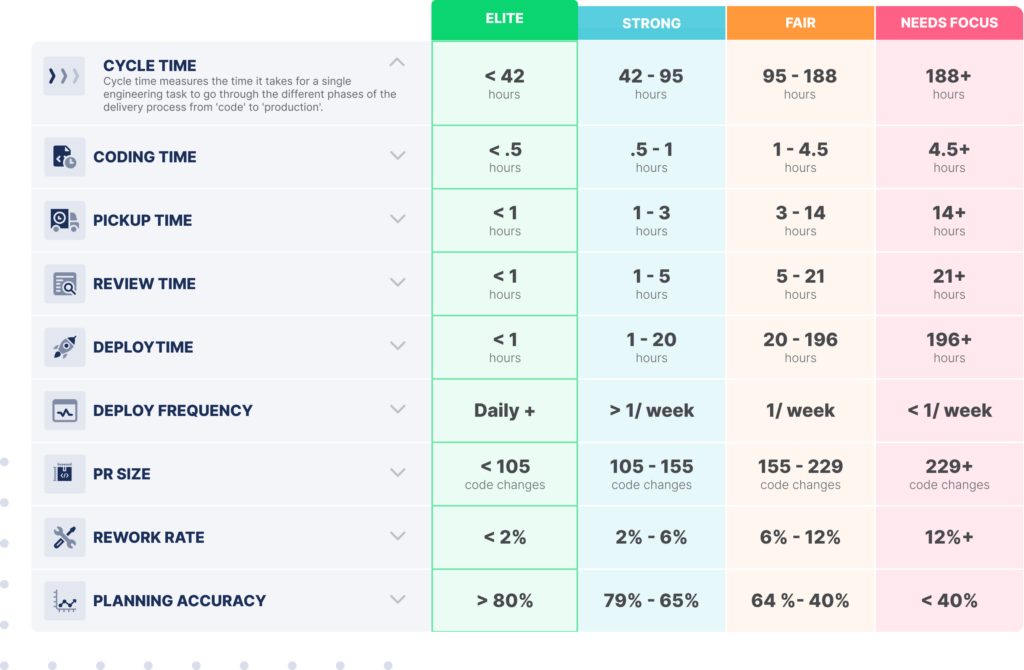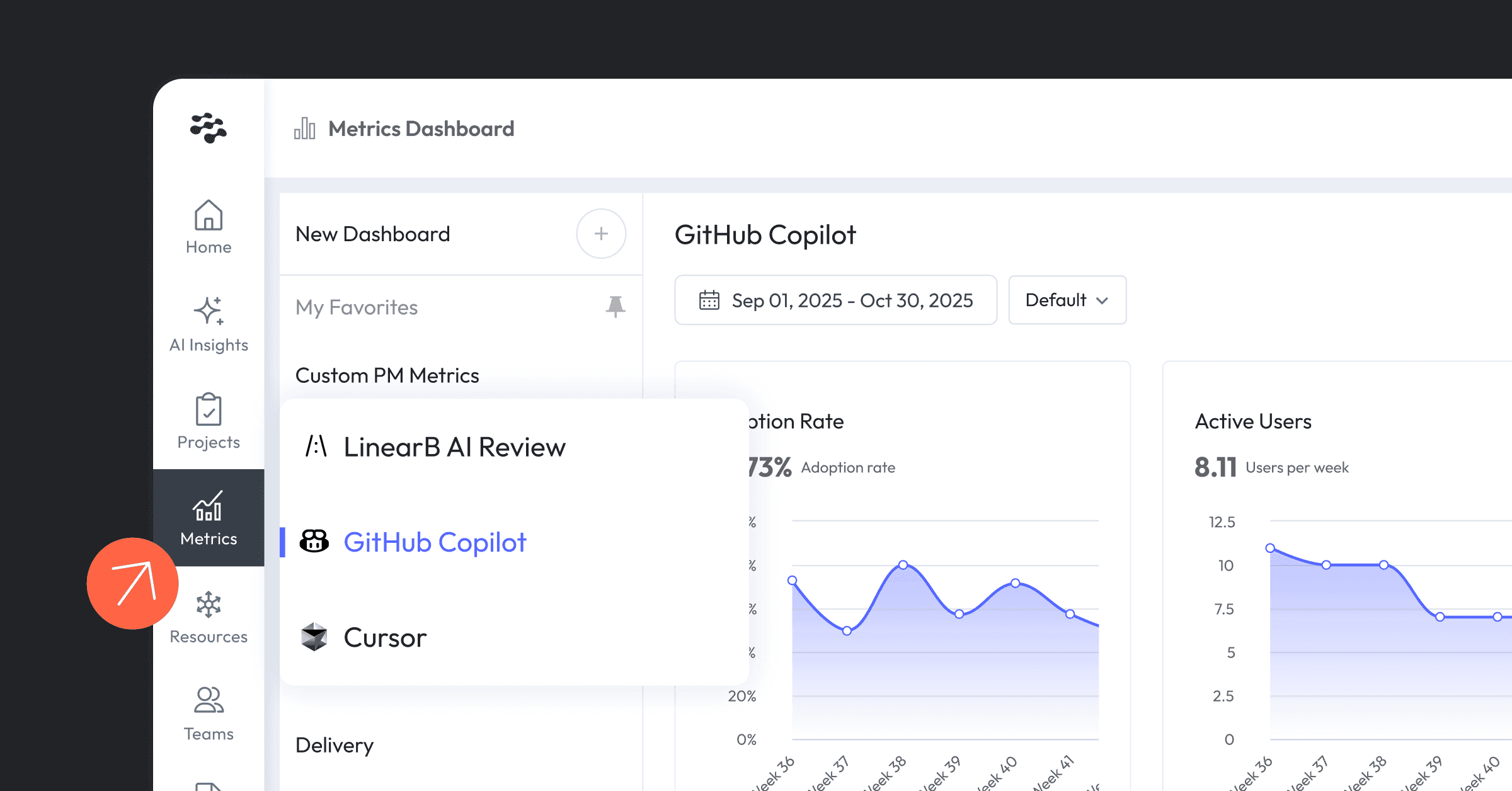Your engineering org is always working hard to push new features and updates. But in today’s world, it’s not enough to know that. You need data to back up what you say, and getting that data isn’t always easy.
If you’re struggling to explain your org’s productivity and show the board how teams are progressing toward delivery, you need engineering management software.
Engineering management software can monitor projects’ current condition and progress over time. These solutions help ensure all parties involved in a complex project are on the same page, whether collaborating with internal teams or external clients.
In this article, we’ll discuss what engineering management software is and some of the best options for your engineering organization.
Table of Contents
- What Is Engineering Management Software?
- Common Engineering Management Challenges
- 8 Popular Engineering Management Tools
- Choosing Engineering Software for the Whole Org
What Is Engineering Management Software?
Management needs vary depending on what type of team you oversee. That’s why you need specialized software tailored to engineering needs when planning and organizing engineering projects.
Engineering management software is a tool that provides data-driven insight into your engineering orgs developer experience, efficiency, and business alignment, which helps you make better business decisions and deliver results.
Software for managing engineering projects is useful for everyone involved in the process — from upper-level management to stakeholders to, of course, the engineers themselves. You’ll get better at time management and organization, simplify the way you collaborate and assign tasks, and reduce costs and risk. You’ll also build clearer and more effective communication, and faster, more centralized file access.
Common Engineering Management Challenges
To give you an idea of what your engineering managers might be up against, consider the following:
Finding the Sweet Spot between Efficiency and Quality
One of the most popular metrics for developers nowadays is velocity — or how quickly they can release new products. And on another extreme, teams could be focusing more on the project’s overall quality, taking time away from releasing new features.
But leaning too far into one or the other will lead to major issues. Getting things out the door faster usually means sacrificing quality. And going at a snail’s pace to get great quality isn’t sustainable in the long run.
With engineering management tools, you’ll be able to visualize how your teams are performing across the board, helping you balance between speed and quality.

Setting Goals and Monitoring Progress
Putting plans on paper is simple, but turning them into reality isn’t. Your leaders need to ensure their teams have clear objectives and measurable benchmarks to strive for.
And it’s difficult to gauge whether devs are progressing toward goals fast enough, let alone see how you can help them improve. Some engineering management tools may offer a Work Breakdown Structure (WBS) to help leaders create a plan for their organization — and actually make it happen.
Managing Productivity and Preventing Burnout
Workload spikes are commonplace in any company, but even more so in new organizations. Since engineers are frequently assigned many tasks, they often end up putting in extra hours. But other times, they don’t have as much work to do.
Managers will have to face the difficulties of balancing output and burnout. Most engineering management tools provide breakdowns of what team members are working on what tasks. And this way, your engineering leaders will be able to break down workloads, preventing dev burnout.
8 Popular Engineering Management Tools
Engineering management platforms will be a great help in overcoming these challenges. But how do you go about choosing one? To help you narrow down your options, we’ve highlighted eight popular engineering management software tools for 2023.
1. Jira
Jira is an agile project management and bug-tracking solution originally designed for and used by remote development teams. Although many companies worldwide have jumped on the Jira bandwagon, the tool’s origins in the issue tracking, agile, and test case management communities make it an exceptionally valuable tool for your engineering organization.
Here are some more Jira features:
- Allows teams to manage projects using Scrum and Kanban, two major ideas in the recent Agile methodology — or even using older, more established project management approaches like the Waterfall method
- Allows users and developers to create plugins that integrate with the app
- Offers built-in reporting features that include metrics like cycle time and deployment frequency, as well as sprint planning tools
But Jira isn’t perfect either. It can be hard to set up, and it doesn’t offer communication features. It also doesn’t allow you to keep an eye on projects’ progress.
2. SourceLevel
SourceLevel offers data and analysis from GitLab and GitHub, such as throughput, lead time, and engagement. You can see the entire delivery pipeline with their data and analytics solution for engineering operations, so your engineering organization can speed up delivery times and improve engineering processes.
Your team leaders will never have to show up to a one-on-one meeting or performance review without the benefit of data and historical context. It allows you to zero down on attainable team and individual KPIs that contribute to overall business goals. Instead of diverging into other discussions, you can focus on the questions leading to a better flow.
However, due to it’s focus on individual performance metrics, there’s a risk of this tool being used for evil, not good, by making it all too easy for your managers to begin stack ranking their devs.
3. Typo
Typo is a software engineering management tool that helps in gaining visibility, removing bottlenecks, and driving continuous improvement among engineering leaders and managers. Using this platform, you can see how developers are doing overall and how satisfied they are with their work. Leaders can zero in on the essentials by looking at the big picture of their teams’ performance. Their team’s velocity, quality, and throughput are all laid out for them. By centralizing the information regarding pull requests, engineering organizations can speed up the review process and decrease cycle time.
It’s much easier for project managers to focus their attention and get everyone on the same page when they can see where their time is being spent. Examining the allocation of resources across unexpected work, issues, and technical debt can let you see where your team is putting in the most time and effort. Ultimately, suggested team goals and automatic alerts in Slack can help engineering organizations boost productivity. Team members are notified automatically and provided with monthly reports to help them stay on track and evaluate their performance.
The biggest downside to Typo is its limited list of Git providers it integrates with.
4. Hatica
Hatica provides remote and on-site engineering teams with the same high-visibility dashboards, insightful data, and efficient processes that have helped other companies achieve breakthrough results. It’s a state-of-the-art analytics platform that allows engineering managers to boost the efficiency, effectiveness, and happiness of their teams.
Hatica integrates with all your workplace apps to give you a complete view of your team’s processes, performance, and outcomes. By encouraging team alignment, speeding up delivery, and boosting engagement, Hatica’s insights guide engineering managers and collaborators toward better outcomes while reducing the likelihood of burnout.
The platform gives engineering teams the insights and workflows they need to perform at their peak. Hatica provides full transparency into all aspects of the work being done, allowing engineering teams to make informed decisions. Users can optimize their development processes by combining data from git, projects, and collaborations with Hatica. You can gauge DevOps performance with system metrics, such as deployment frequency, lead time, MTTR, and change failure rate.
But like many of these engineering management tools, simply tracking metrics doesn’t give you the insights you need to start improving. This is why LinearB conducted an extensive study on what it takes to be an elite engineering team so you can use metrics to benchmark your org and set goals for areas that need improvement.

5. Uplevel
Using Uplevel, you can see how your engineering efforts affect the well-being of your team in a quantitative way. You can use the platform’s actionable insights to motivate your teams to think innovatively and maximize productivity.
Uplevel’s feature specifically made for C-suite executives, Executive Insights, is a dashboard built with Tableau’s business intelligence tools that displays the activities and development of engineering teams. The dashboard provides visibility into a variety of metrics, including the amount of time spent in focused work by developers, the amount of time spent in meetings and on Slack, and the average project cycle time for various engineering teams. You may quickly identify regional, role, and team-specific trends in software engineering productivity simply by hovering over data points.
The biggest downside to Uplevel is its limited list of project management tools it integrates with.
6. Embold
Embold is an easy-to-use static code analyzer powered by AI that can aid developers in analyzing and improving their code. Its unique selling point is that it can examine code on four different types of issues: bugs in the code itself, problems with the design, metrics, and duplication.
The Embold Score is based on these four factors, and it includes a feature that highlights possible risks and organizes the list of issues in need of attention. It reveals which parts of a system are most likely to affect the rest and hence must be addressed first. Embold supports over 17 languages and effortlessly works with version control systems, IDEs, and build systems.
Embold gives your developers all the tools they need to create excellent code from the ground up. With Embold’s in-depth analysis and visually appealing interface, developers can gain a thorough understanding of their software and codebase and make timely, high-quality releases. By prioritizing software design, Embold equips developers with everything they need to gain a rapid understanding of the current framework and frees up their time to focus on building high-quality software.
Unlike many of the other engineering management tools, Embold focuses primarily on providing insights to developers rather than insights that help team leads, managers, or even the VP of Engineering make better decisions in how they manage their teams.
7. Propelo
The Propelo Engineering Excellence platform analyzes information from all of your DevOps tools in order to provide the necessary insights that will allow you to speed up software delivery and improve developer productivity and security. With the help of Propelo, engineering managers can improve their judgment with hard data to make more well-informed decisions.
Software development in the present day requires both quick decision-making and smart automated actions from engineering teams. Propelo combines these two crucial factors: AI-driven intelligence to aid in drawing conclusions supported by data and no-code RPA to turn that intelligence into action and relieve strain on developers.
The platform was designed specifically to help engineering teams achieve new heights of performance by increasing transparency, integrating development, QA, DevOps, security, and product management, and facilitating collaboration between the various roles involved. Propelo integrates and analyzes data from more than 40 different DevOps tools. The platform offers a free trial so you can check whether it fits the needs of your organization.
8. LinearB
LinearB is a real-time productivity analysis tool and one of the top Git tracking solutions available. It can help keep an eye on the big picture of your teams’ productivity, identify bottlenecks, and notify engineering managers of any issues that may arise.
LinearB tracks how long developers spend on specific kinds of work. So it can track how fast different people in the team are moving and estimate how long it’ll take to complete a project. It also offers insights into the metrics that matter most to an engineering org, including DORA metrics, so you’re armed with the data you need to show off at the next board meeting.
LinearB can correlate your Git activity and your project management data, provide industry benchmarks, and help you improve your metrics, not just track them, using two workflow automation tools: WorkerB and gitStream. These powerful tools help you streamline your processes, reducing the time devs have to spend on repetitive tasks — and maximizing their productivity.
WorkerB helps you keep developers in sync. And it can:
- Simplify the PR review process
- Create tickets automatically to properly track work
- Expand your technology stack by integrating apps you’re already using, like Jira and Slack

And with gitStream, you’ll reduce the time spent on PRs. Here’s what this tool does:
- Enables you to set up .cm file review automations in the repo so each PR gets the right amount of attention
- Allows you to skip the manual review process and immediately merge PRs containing just minor changes, such as text updates, photos, or CSS
- Redirects pull requests to the proper reviewers if a more in-depth look is required.
Listen to LinearB co-founders, Dan Lines and Ori Keren explain how gitStream will help engineering teams overcome PR process obstacles:
Choosing Engineering Management Software for the Whole Organization
Engineering management software is crucial for you to track and prove your engineering org’s performance. The right platform will empower you to walk into board meetings with your head held high, confident of the data you have.
And when you choose an engineering management platform like LinearB, you’ll maximize your energy and time savings. Our tool doesn’t just collect and organize data for you, it helps you see where bottlenecks are happening, and even enables you to eliminate inefficiencies and improve your processes.





